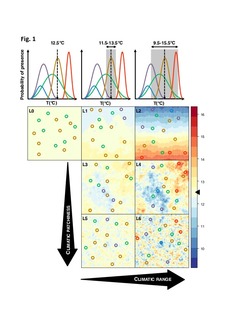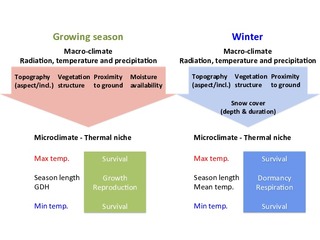| dc.contributor.author | Graae, Bente Jessen | |
| dc.contributor.author | Vandvik, Vigdis | |
| dc.contributor.author | Armbruster, W. Scott | |
| dc.contributor.author | Eiserhardt, Wolf L. | |
| dc.contributor.author | Svenning, Jens-Christian | |
| dc.contributor.author | Hylander, Kristoffer | |
| dc.contributor.author | Ehrlén, Johan | |
| dc.contributor.author | Speed, James D.M. | |
| dc.contributor.author | Klanderud, Kari | |
| dc.contributor.author | Bråthen, Kari Anne | |
| dc.contributor.author | Milbau, Ann | |
| dc.contributor.author | Opedal, Øystein Hjorthol | |
| dc.contributor.author | Alsos, Inger G. | |
| dc.contributor.author | Ejrnæs, Rasmus | |
| dc.contributor.author | Bruun, Hans Henrik | |
| dc.contributor.author | Birks, H. John B. | |
| dc.contributor.author | Westergaard, Kristine Bakke | |
| dc.contributor.author | Birks, Hilary H | |
| dc.contributor.author | Lenoir, Jonathan | |
| dc.date.accessioned | 2018-03-21T09:40:48Z | |
| dc.date.available | 2018-03-21T09:40:48Z | |
| dc.date.created | 2017-12-22T13:18:27Z | |
| dc.date.issued | 2017 | |
| dc.identifier.issn | 1433-8319 | |
| dc.identifier.uri | http://hdl.handle.net/11250/2491414 | |
| dc.description.abstract | In the face of climate change, populations have two survival options − they can remain in situ and tolerate the new climatic conditions (“stay”), or they can move to track their climatic niches (“go”). For sessile and small-stature organisms like alpine plants, staying requires broad climatic tolerances, realized niche shifts due to changing biotic interactions, acclimation through plasticity, or rapid genetic adaptation. Going, in contrast, requires good dispersal and colonization capacities. Neither the magnitude of climate change experienced locally nor the capacities required for staying/going in response to climate change are constant across landscapes, and both aspects may be strongly affected by local microclimatic variation associated with topographic complexity. We combine ideas from population and community ecology to discuss the effects of topographic complexity in the landscape on the immediate “stay” or “go” opportunities of local populations and communities, and on the selective pressures that may have shaped the stay or go capacities of the species occupying contrasting landscapes. We demonstrate, using example landscapes of different topographical complexity, how species’ thermal niches could be distributed across these landscapes, and how these, in turn, may affect many population and community ecological processes that are related to adaptation or dispersal. Focusing on treeless alpine or Arctic landscapes, where temperature is expected to be a strong determinant, our theorethical framework leads to the hypothesis that populations and communities of topographically complex (rough and patchy) landscapes should be both more resistant and more resilient to climate change than those of topographically simple (flat and homogeneous) landscapes. Our theorethical framework further points to how meta-community dynamics such as mass effects in topographically complex landscapes and extinction lags in simple landscapes, may mask and delay the long-term outcomes of these landscape differences under rapidly changing climates. | nb_NO |
| dc.language.iso | eng | nb_NO |
| dc.publisher | Elsevier | nb_NO |
| dc.rights | Attribution-NonCommercial-NoDerivatives 4.0 Internasjonal | * |
| dc.rights.uri | http://creativecommons.org/licenses/by-nc-nd/4.0/deed.no | * |
| dc.title | Stay or go – how topographic complexity influences alpine plant population and community responses to climate change | nb_NO |
| dc.type | Journal article | nb_NO |
| dc.type | Peer reviewed | nb_NO |
| dc.description.version | acceptedVersion | nb_NO |
| dc.source.pagenumber | 41-50 | nb_NO |
| dc.source.volume | 30 | nb_NO |
| dc.source.journal | Perspectives in plant ecology, evolution and systematics | nb_NO |
| dc.identifier.doi | 10.1016/j.ppees.2017.09.008 | |
| dc.identifier.cristin | 1531528 | |
| dc.relation.project | Andre: VILLUM Investigator project (VILLUM FONDEN, grant 16549). | nb_NO |
| dc.relation.project | EU/European Research Council (ERC-2012-StG-310886-HISTFUNC) | nb_NO |
| dc.relation.project | Nordforsk: Project number 29662 to BJG | nb_NO |
| dc.description.localcode | © 2017. This is the authors’ accepted and refereed manuscript to the article. Locked until 11.11.2019 due to copyright restrictions. This manuscript version is made available under the CC-BY-NC-ND 4.0 license http://creativecommons.org/licenses/by-nc-nd/4.0/ | nb_NO |
| cristin.unitcode | 194,66,10,0 | |
| cristin.unitname | Institutt for biologi | |
| cristin.ispublished | true | |
| cristin.fulltext | postprint | |
| cristin.qualitycode | 2 | |



